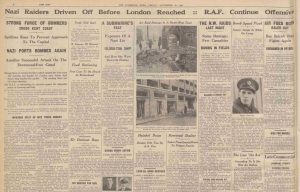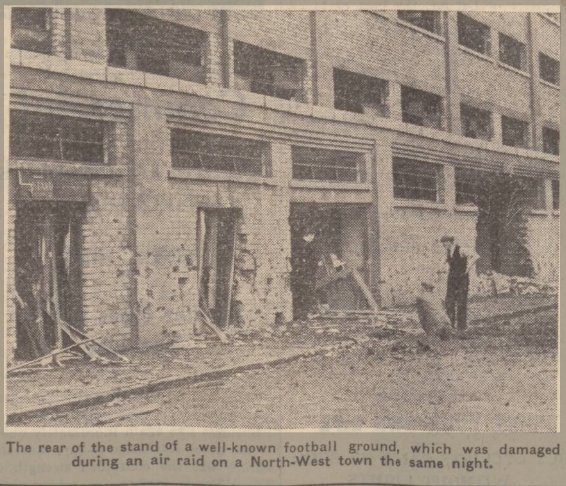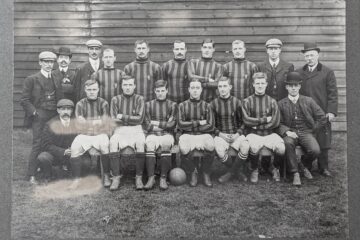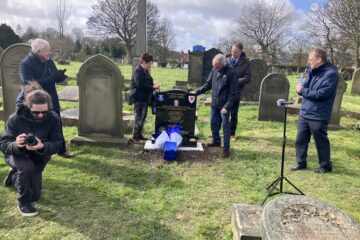Merseyside was badly hit by enemy air raids during the Second World War, which peaked during the May Blitz of 1941.
However, the bombing had begun the previous summer, with attacks increasing during September 1940. On the night of 18/19 September, several bombs landed in the Everton and Walton area, including Gwladys Street, causing serious injury to nearby residents while also damaging the Gwladys Street Stand. In Bullens Road, a bomb dropped 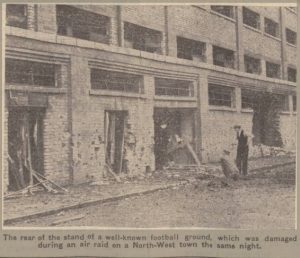 in the school yard opposite, badly damaging the exterior wall of the stand, while also perforating the roof. A third bomb hit the outside of the practice ground (to the rear of the Park End Stand) demolishing the surrounding hoarding, and blowing out windows in houses in Goodison Avenue and Walton Lane.
in the school yard opposite, badly damaging the exterior wall of the stand, while also perforating the roof. A third bomb hit the outside of the practice ground (to the rear of the Park End Stand) demolishing the surrounding hoarding, and blowing out windows in houses in Goodison Avenue and Walton Lane.
On Saturday, 21 September, an Emergency Meeting of the Board was convened at Goodison, where it was resolved to call in Archibald Leitch’s company* to give a valuation of ‘the complete renewal of damaged properties, and that a claim should be forwarded to the War Damage Claims department within the prescribed 30 Days’ – thereby passing costs onto the government. They envisaged this would cover ‘the demolition of a large section of the New Stand outer wall in Gwladys Street; destruction of all glass in this Stand; damage to every door, canteen, water and electricity pipe and all lead fittings; and the perforated roof in hundreds of places.’ 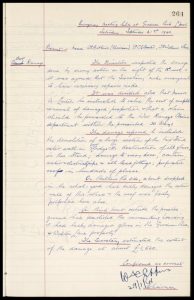 Also included was the damage to Bullens Road, the window damage to the Goodison Avenue and Walton Lane properties, plus the practice ground hoarding. The club secretary Theo Kelly, estimated the cost of this extensive damage to be about £1,500.
Also included was the damage to Bullens Road, the window damage to the Goodison Avenue and Walton Lane properties, plus the practice ground hoarding. The club secretary Theo Kelly, estimated the cost of this extensive damage to be about £1,500.
Minutes from Emergency Meeting of the Board, 21 September 1940
Due to wartime restrictions, no report appeared in the local news, but a photograph of the damaged Bullens Road outer wall appeared two days later, described as ‘The rear of the stand of a well-known football ground in north-western town’, still keeping to war-time anonymity. Detailed news of the damage was even kept from Everton fans who were due to attend Goodison only three days after the bombing for a first team match against Chester in the newly organised war-time Northern League. The game went ahead with no reference at all to the state of the stands – the match reports later concentrating instead on Tommy Lawton’s sixteen-minute hat-trick in a 4-3 victory. However, this was to be no full-to-capacity 70,000 attendance, later witnessed at several post war games, as government war-time restrictions also prevented the gathering of large crowds, which included football grounds, and many regular fans were already called up or engaged in war work. Crowds were limited to 8,000 in evacuation areas, and 15,000 elsewhere, although this was gradually relaxed as the government acknowledged the importance of the game as recreation for the working man. Attendances of around 5,000 at Goodison and Anfield became the wartime norm. No doubt modern Health & Safety measures would see the ground closed until repairs were completed. Different times indeed.
[*Archibald Leitch designed stands or full stadiums at over 20 football grounds in the UK and Ireland between 1899 and 1939, including parts of Goodison and Anfield. He lived in Formby and died in 1939].
Mike Royden, Everton Heritage Society
[This article originally appeared in the Everton v Leicester City Matchday programme, 31 January 2018]
